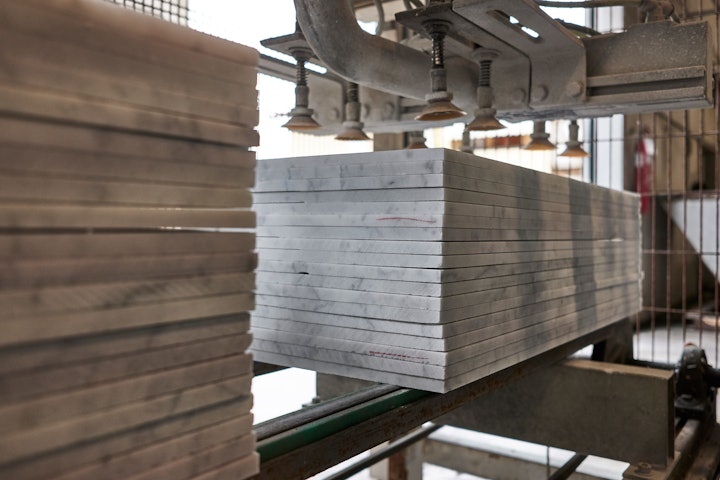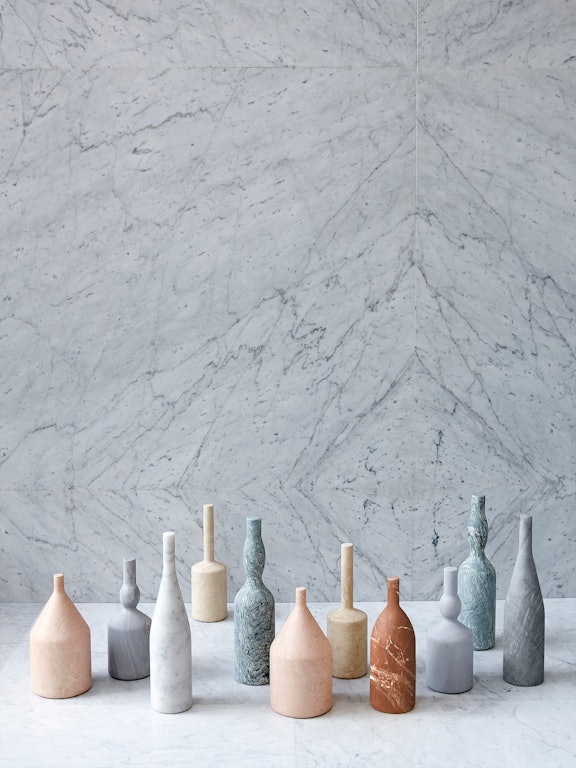The winning combination of quality and craftsmanship in natural stone
03.2022
When it comes to creating beautiful designs from natural stone, there is no substitute for traditional craftsmanship
Craftsmanship and quality: a winning recipe for natural stone
The story of natural stone is a long and fascinating one, dating back over millennia and inspiring extraordinary sculptures, monuments and designs.
Today, despite the leaps made in technology and tools, the artisanal approach to stone remains as important as ever when it comes to creating unique and beautiful works of art.

Quality and craftsmanship: the Salvatori philosophy
The spirit of innovation is in the Salvatori DNA and goes hand in hand with attention to detail and experience of working with natural stone for over seven decades, with every phase of a product’s creation entrusted to a close-knit team of expert craftsmen.
Their work begins when huge blocks of stone arrive in the Salvatori yard in Northern Tuscany. Being a natural material, no two blocks are alike and they must therefore be categorised by tonality, so that families of products will share consistent colours and veining.
The majority of products we make first undergo some sort of cutting or processing that involves a machine, but even here, it’s not merely a matter of feeding pieces in one end and waiting for them to emerge at the other. An expert eye is needed to calibrate the settings and adjust them as needed throughout the process.
Once a piece emerges from the machine, it is picked up, turned every which way and scrutinised for any imperfection and this is where it takes a true expert to distinguish between those tiny lines or marks that are intrinsic to the stone’s look and personality and a structural flaw that could undermine the product’s quality and performance.

The unpredictability of stone
Prized since time immemorial as a noble and versatile material, natural stone has long been used for imposing places of worship, royal residences and buildings of importance. Today, it is used for all this and more, from contemporary artwork to modern furniture and accessories.
Undoubtably, one of the major reasons for its success is its extraordinary durability, but that would be to short change its aesthetic appeal. What makes natural stone so special and unique is its glorious and varied veining, the consequence of a metamorphic process that takes place over millions of years.
The particular climatic conditions and geographic habitat of a rock’s location combine in a myriad of ways to contribute to the formation of a dazzling array of marbles, limestones and other types of stone.
Just as every snowflake is different from another, so too are the elements that you find in every block of stone, from porosity to salt, from colours to stripes or patterns.
This is the magic of a material that is gifted to us by nature and, even the most skilled “forger” in terms of a manufacturer or artist, cannot ever replicate that X factor.
Stone has an inherent, unpredictable beauty that we believe requires only the lightest of twists or flourishes, rather than ostentatious or complicated embellishment.

Why craftsmanship still matters in the 21st century
As we have said, the artisanal approach to stone has its origins in a distant past, using techniques such as carving and sculpting to create famous buildings and works of art that are still revered today.
The secrets of working with this precious material have been handed down from generation to generation, with those who are privy to them a prized and fortunate group.
Over the years, technology has seen the development of new machinery that can cut or hone stone with a level of almost unimaginable precision, but this has not led to the role of the stone worker becoming obsolete. Instead, technology and craftsmanship coexist in harmony.
So, what is the reason for this unusual but happy situation, which runs contrary to modern progress and tendencies?
It all comes down to the fact that, unlike manmade products or materials, stone’s natural origins make it extremely varied and unpredictable. Only a trained eye can interpret and understand what lies beneath the surface of a block or slab of stone, or can predict which line could hide a potential crack.
For example, the tiny holes of Bianco Carrara or the coppery blemishes that appear in Gris du Marais® marble could seem defects to the layperson. The experienced artisan, however, recognises and values these characteristics that are the unique markings that are simply part of their make-up and fascination.
The techniques developed and fine-tuned over the centuries, imprinted in master artisans through learning and what you could describe almost as osmosis, are just as important today as when Michelangelo sculpted his David.

From selecting the right block to knowing that a piece just needs one last gentle pass of abrasive paper to be absolutely perfect, this is the skill of a true craftsman.
A simple but telling example of the synergy between quality and craftsmanship is the Omaggio a Morandi collection of decorative accessories, in a homage to the eponymous Italian painter. Each piece may sit just 30 cm high, but it all starts with studying a large block of marble and understanding how its veining or particular patterning will impact on the look of the final product.
Then, it’s that final caress and quality check as it is honed by the hand of Giovanni or one of his colleagues, that ensures every piece that leaves our workshop is a homage not only to Giorgio Morandi but also to the stone that nature has gifted us.
Hand finishing releases the warmth and, we might even say, the true essence of stone, allowing every single product, from the smallest paperweight or soap dish to a textured tile to a bathtub or oversize dining table, to tell its own unique story.
For Salvatori, there is no substitute for the human hand and eye when it comes to working with natural stone.
This extraordinary material deserves loving attention and care and for us, it’s traditional craftsmanship that takes the quality and beauty of each piece to another level.





